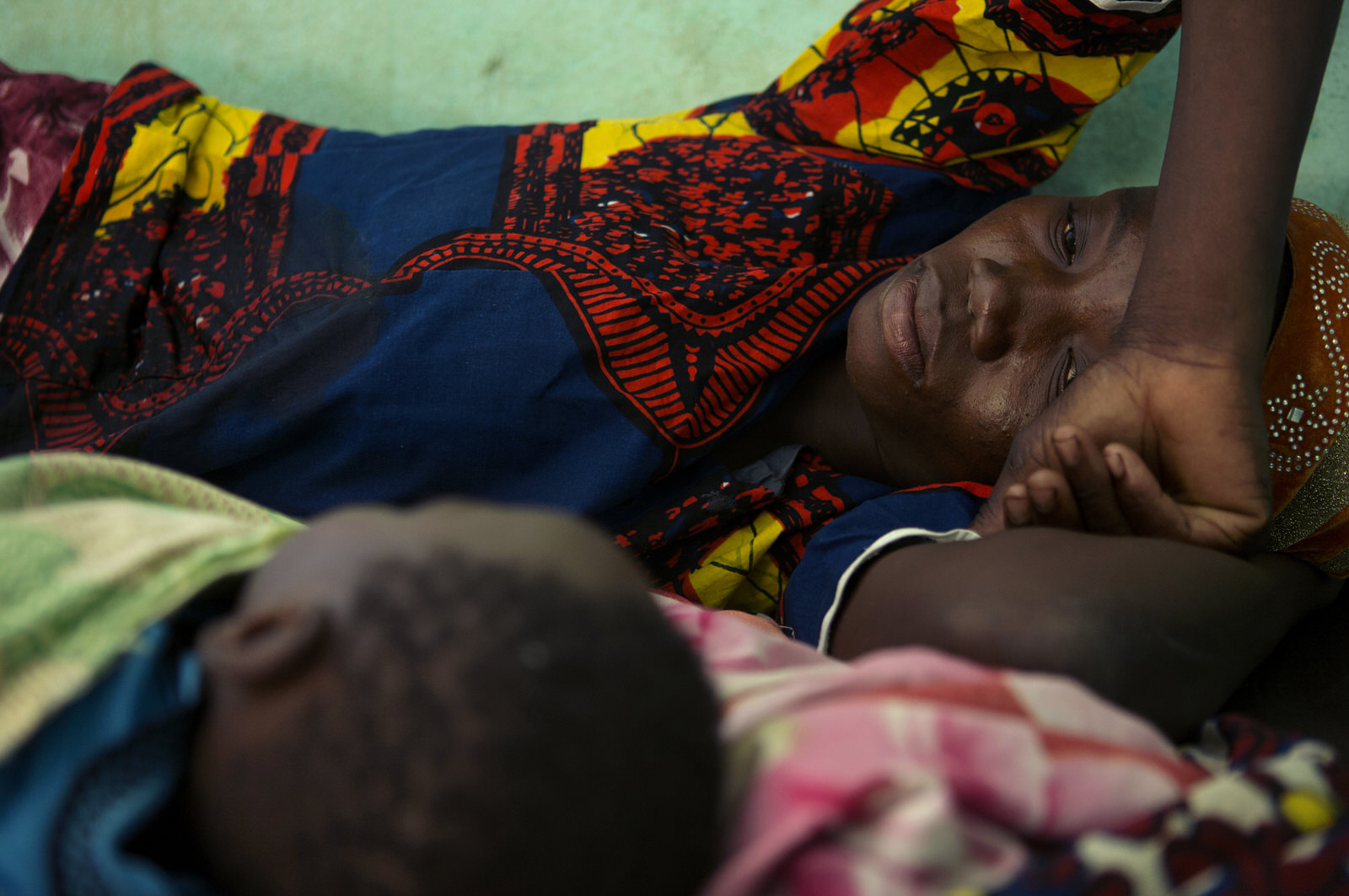
Women wait to see the doctor at a health clinic in Soumousso, Burkina Faso in June 2016. Most patients there that day showed symptoms of malaria. Nearly 40% of Burkina Faso’s residents contract the disease every year, and it is one of the country’s leading causes of death.
Sanou Rosalie lies with her baby, Sanou Karmel, who has severe malaria, at a health clinic in Soumousso. Young children and pregnant women are most at risk of contracting the disease, which takes a heavy toll on this rural farming community in western Burkina Faso.


Nanema Abdul Razak, 7, at the Soumousso health clinic with a fever, receives a shot from Dr. Moumouni Konate.
Abdoulaye Diabate, center, a lead entomologist at the Research Institute of Health Sciences in Bobo-Dioulasso, is involved in a number of the malaria eradication efforts under way in Burkina Faso. One of the challenges they face, Dr. Diabate says, is that most mosquitoes in the region are now resistant to older insecticides like DDT, as well as newer ones like those used on bed nets. Here, he oversees students at their lab at Centre Muraz, where they’re developing a transgenic fungus to attack malaria-carrying mosquitoes.


Ouattara Yaya checks on the cattle that are kept in the mosquito sphere, a large screened-in facility in the village of Soumousso that serves as a field station for scientists from the nearby city of Bobo-Dioulasso. The sphere was created to replicate the outdoor environment so that scientists can test in a controlled setting the tools they’re developing to combat malaria, including the transgenic fungus.
Ouattarra Moussa, right, and Sare Boureima, center, collect mosquito larvae that have hatched in standing puddles along the village roads in Soumousso. In the evenings, men from the community join the scientists to collect samples, which they’ll bring back to the mosquito sphere for experimentation.


Ouattarra Moussa looks for mosquito larvae in standing puddles. These large pools of water are a prime breeding ground for mosquitoes. Most of the mosquitoes collected from the field here are resistant to existing insecticides.
Mosquito larvae are collected from puddles that mark the landscape.


Ouattara Baladji, the Chief of Soumousso, says the community has become accustomed over the years to the scientists working among them. Some of the first testing of insecticide-treated bed nets was done here decades ago, and the chief remembers as a young man participating as a “sleeper,” spending the night under the new nets to determine their effectiveness.
Etienne Bilgo searches for mosquitoes on a cow in one of the experimental huts in the Soumousso field station. During the experiment, released mosquitoes take a blood meal from the cow and then land to rest, with many attracted to a hanging black cloth that is covered in the transgenic fungus. The team collects the mosquitoes in the morning to bring back to the lab, where they will test how the insects have interacted with the fungus, and how long it takes for the fungus to kill them.


Sare Issiaka, left, uses a mouth aspirator to move mosquitoes for experimentation as Ouattara Kader looks on, at the fungal lab in Centre Muraz in Bobo-Dioulasso where the team is developing the transgenic fungus. In this work, they have partnered with scientists from the University of Maryland.
Yaro Djibi waits with a net for mosquitoes in the village of Vallee du Kou. Male mosquitoes congregate in swarms at dusk, says Diabate, who studies male mating behaviors. Better understanding their behavior, he says, will allow scientists to create more effective control techniques. One approach under investigation involves the release of genetically modified mosquitoes that would be used to eliminate a malaria-carrying species.


N’do Severin, a research engineer whose focus includes insecticides, works at the field station in Vallee du Kou, where new combination insecticides are tested for efficacy. The village is surrounded by rice fields, which provide ample mosquito breeding grounds.
Ouattara Abdoulaye, a research technician on the insecticide testing team, works in one of the test huts in Vallee du Kou. Insecticide resistance is widespread here, and the common bed net in use today kills only a tiny fraction of the insects. The team is looking for new combination insecticides that can be used on bed nets and for indoor spraying.


As night falls in Vallee du Kou, a member of the field team searches for mosquitoes to bring back to the lab. Diabate says he was driven to dedicate his life to beating back malaria after falling sick with the disease multiple times as a child, and seeing the continued toll it has taken on his community.
Amsetou Konseibo waits to see the doctor at the Soumousso Health Clinic in June 2016. Malaria’s toll exceeds the health burdens, experts emphasize, and has much broader economic costs that are tied to a country’s development. “Poverty leads to malaria, and malaria, of course, also creates poverty,” says Diabate. But he is optimistic: “We will be able to eradicate malaria…it’s going to take time. It’s going to take also a lot of commitment, but one day, we will get there.”
Photos and Text: SARAH WEISER / RETRO REPORT


